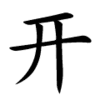开
| ||||||||
Translingual
| Stroke order | |||
|---|---|---|---|
 | |||
| Stroke order | |||
|---|---|---|---|
Han character
开 (radical 55, 廾+1, 4 strokes, cangjie input 一廿 (MT), composition ⿱一廾)
References
- KangXi: not present, would follow page 353, character 10
- Hanyu Da Zidian: volume 1, page 514, character 3
- Unihan data for U+5F00
Chinese
Etymology 1
| For pronunciation and definitions of 开 – see 幵 (“even, level”). (This character, 开, is a variant form of 幵.) |
Etymology 2
| For pronunciation and definitions of 开 – see 開 (“to open; to unlatch; to unfasten; to start; to turn on; to switch on; etc.”). (This character, 开, is the simplified form of 開.) |
Notes:
|
Vietnamese
Han character
- This term needs a translation to English. Please help out and add a translation, then remove the text
{{rfdef}}.
References
This article is issued from
Wiktionary.
The text is licensed under Creative
Commons - Attribution - Sharealike.
Additional terms may apply for the media files.